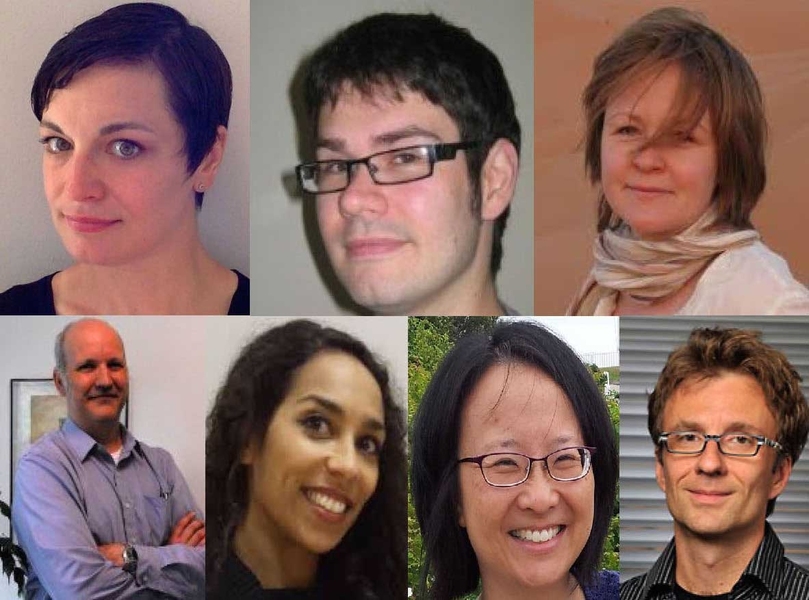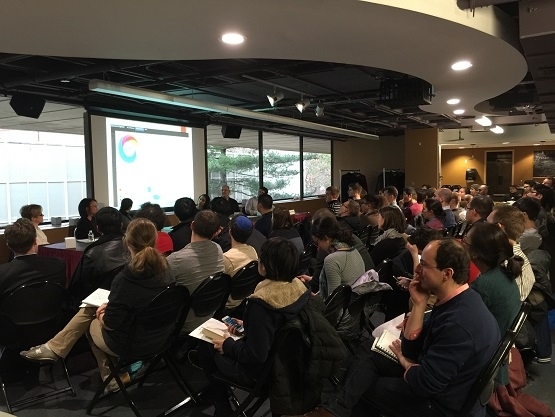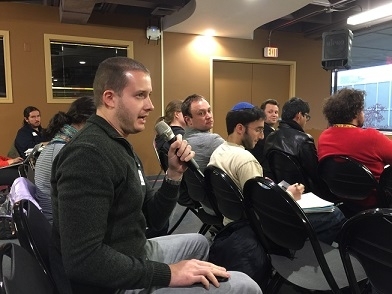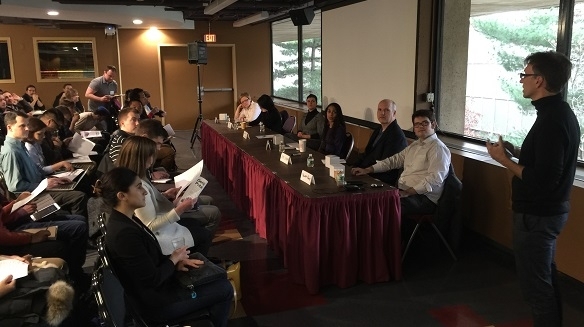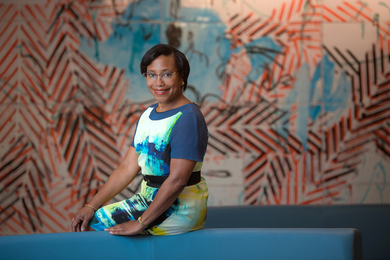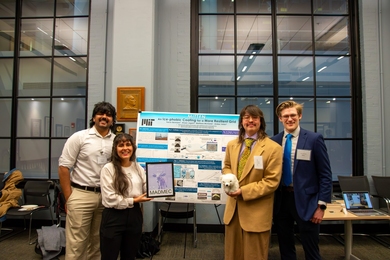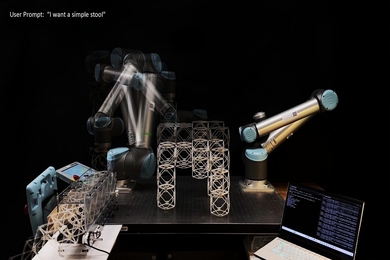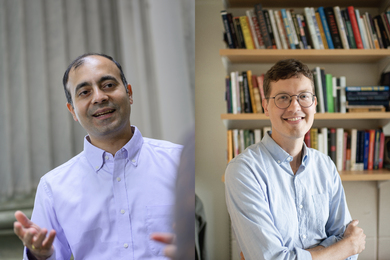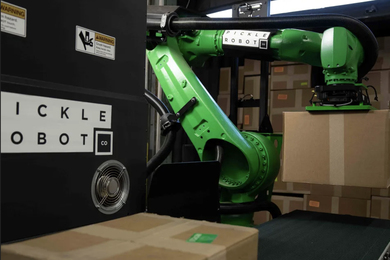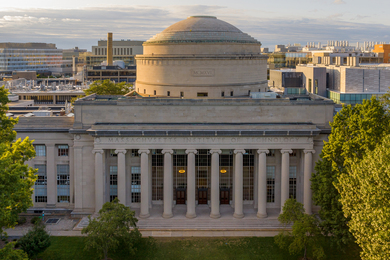Finding the right outlet to publish scientific work is crucial for students, postdocs, and faculty. With significant changes in the publishing landscape — a proliferation of new journals, new publication models such as open access, and the introduction of new metrics to assess the impact of a paper — an open discussion of these matters is critical to better connecting scientists and publishers.
The MIT Department of Civil and Environmental Engineering (CEE) hosted a “Getting Published” panel on Monday, Nov. 30, convening a conversation on publishing from different angles. The event was open to the MIT community and provided a unique opportunity to meet experienced professionals, gain insights into the editorial processes, and discuss where scientific publishing is heading. The panel covered aspects of open access publishing, innovative models of peer review and publishing, and related topics.
Each of the panelists gave a short introduction about his or her work, then opened the floor to questions. The event focused on the challenges and opportunities inherent in publishing, including current best practices and emerging new publishing models. The audience included about 100 graduate students, postdocs, and faculty from across MIT, who participated in an active discussion.
The speakers, who offered insights from both the journalism and scientific sides of publishing, included:
- Stewart Bland, senior publisher and editor of Materials Today;
- Rosamund Daw, senior editor at Nature;
- Anna Demming, editor at the UK-based Institute of Physics Publishing;
- Quincey Justman, scientific editor at Cell Systems;
- Nick Lindsay, journals director at The MIT Press; and
- Corie Lok, research highlights editor at Nature.
“Practically all the editors put the importance of good writing at the top of their recommendations,” said CEE Professor Martin Polz, who served as moderator. “No one is going to rewrite your paper for you, so the author needs to put the effort upfront into preparing clear and concise communications.”
“Writing a paper makes everything concrete,” said Quincey Justman of Cell Systems. “Show rather than tell, and make language concrete and testable. Give striking, explicit observation to make people think in a new way about the problems they care about. Ultimately, you want a relationship match between your philosophy and the reader’s.”
Nature’s senior editor Rosamund Daw said you can help to get your message across by including good schematics to explain complex problems or ask a scientist in an unrelated discipline for comments. She also looks for a narrative with a clear beginning, middle, and end. “Demonstrate generality and utility whenever possible,” she said, adding “and include a cover letter [to the editor] explaining the key findings and why you think they are important.”
“You might have a model that you’re working with,” noted the Institute of Physics’ Anna Demming, “but see where you might need to tweak things a bit to stay current. We live in an age of information, multimedia and open access, not dissimilar to the scientific process.”
“Open Access” is a term commonly used for a movement that promotes free availability and unrestricted use of research and scholarship, according to the MIT Libraries. “That’s about all we talk about now,” said The MIT Press Journals Director Nick Lindsay. “Three to five years ago it was not really discussed, but we’re beginning to see a hockey stick effect where it’s really taking off fast.”
Stewart Bland from Materials Today suggested letting editors know if you want to be considered as a referee for papers they receive from other authors. CEE doctoral student Kai Pan asked how far removed does someone need to be from the author to be considered for peer review. Bland said it’s ultimately the editor’s judgment call, but most likely it’s not appropriate if you know the author personally. Justman added that sometimes if the research field is so small, it might be acceptable for editors to ask other people within your circles for a review. “Breakdowns in disciplines and standards in the field are evolving which is influencing the field,” she said, adding a recommendation for The Royal Society's recent publication, “The Future of Scholarly Scientific Communication.”
Another lively discussion surrounding peer review was this year’s Pachter’s P-value Prize, University of California at Berkeley Professor Lior Pachter’s crowdsourced challenge offering a cash prize for justifying a reasonable null model and a p-value associated to a particular statement in a genomics scholarly paper (known as the KBL paper) published by Nature. Over the course of the pubic and scientific discourse, there were more than 1 million page views on Pachter’s Pachter's blog, a testament, he says, “to the fact that the collective peer reviewing taking place on these pages is not only of very high quality, but also having an impact.”
“Post-publication peer review is coming,” said Justman. “Reviews are becoming much more than about the science; and the process is becoming more democratic.” Pachter himself describes the challenge as a glimpse of what scientific discourse can look like when not restricted to traditional publishing channels.
Other audience questions and panel answers included:
Q. When do you know when your research is ready to be published?
A. Agree with your advisor on when your work is done, and don’t worry about the length of your paper.
Q. What if you get a lot of papers to publish at the same time?
A. Editors look for parallels, and cross-referees weigh in, too.
Q. How important is name and recognition in work that gets published?
A. It’s not important, it’s about the science.
Q. Are there strategies editors use to mitigate/handle biases?
A. Yes, but they’re not perfect. For example, Daw responded that Nature recently introduced double-blind peer review for authors [authors/institutions not revealed to peer reviewers] and that has had some impact. “Authors from China who feel there is some bias are probably the biggest users of that facility,” she said. “We’re always looking for different models for improvement and talking internally and externally with other academics about how to ensure fairness.”
Q. In which order do you read a manuscript? Generally, do you look at big things first, or read through the whole paper? What’s the biggest attention getter?
A. Demming says it depends on the paper while Justman likes to look at the figures. “But it’s not a cookie cutter approach,” Justman explained, “and please write your best abstract. A terrible abstract can get your paper in trouble.” Nature’s Corie Lok added that there are more opportunities for younger researchers to get the word out given the new opportunities in publishing such as writing opinion/editorial pieces in news outlets and contributing to blogs.
Daw’s presentation included a list of tips from which any scholarly researcher could benefit. Overall, she said, the science should speak for itself, but these pointers help get the message across in the best possible way:
- Ask a scientist in an unrelated discipline for comments.
- Include schematics to explain complex concepts.
- Relegate technical detail to "Supplementary Data."
- Focus on the key conceptual advance; don’t get sidetracked.
- Tell a complete story: Avoid “salami slicing.”
- Demonstrate generality and utility, where appropriate.
- Reference and debate the performance of competing technologies compared to yours.
- Avoid the temptation to hype.
- Be selective.
“Publishing is a critical step to share with the world the insights of the research done in the lab — the methods, theories, and conclusions,” summarized CEE department head, Professor Markus Buehler. “Hearing the publishing perspective from the ‘other side’ — from the editors and publishers — was a very valuable experience. The panel brought together thought-leaders who understand the power of peer-review, which now transcends into new models of publication that help accelerate scientific discussion in an open format.”
